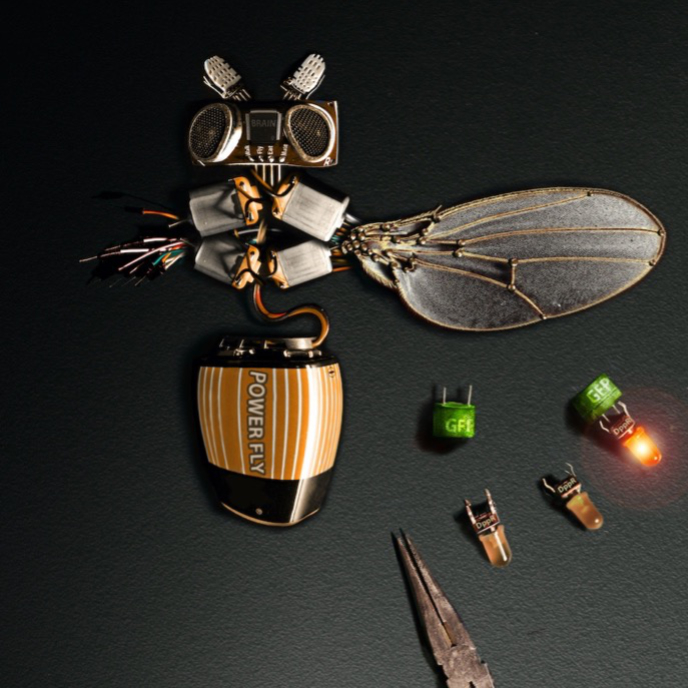 Maths, Physics & Chemistry
Maths, Physics & Chemistry
Strip it out and build it back! Engineering a morphogen gradient
Morphogens are biological molecules that instruct patterning in developing tissues. We used an artificial morphogen to guide development in the fruit fly wing. By doing so, we simplify the biological complexity, allowing us to decipher how morphogens work.

Imagine finding yourself in a thick crowd of people and having to figure out your whereabouts. Before the advent of smartphones, you used to have two main options: asking someone, or inspecting your surroundings in hopes of recognizing any landmarks. The smell of fresh bread from a nearby bakery might be enough of a hint! This is not unlike the challenge cells are faced with during the early stages of an organism's embryonic development. While all the cells in this organism carry the same genetic material, a cell's position within the organism dictates its role, and thus the subset of genes it needs to activate. It is thus fundamental that cells figure out where they are relative to each other efficiently and precisely.
One of the mechanisms that make this possible uses special molecules known as morphogens. Cells are able to measure morphogen concentration in their vicinity, and when this concentration exceeds or falls below specific thresholds, the cell triggers the expression of specific genes. Similar to the example of the bakery above, each cell estimates its distance from the region of the tissue where morphogens are secreted by "smelling" its surroundings: the higher the concentration, the closer the source. Intuitively, this mechanism only works if the concentration of morphogens is sufficiently different at different distances, so not all concentration profiles are equally informative.
The importance of morphogens in particular instances of development is uncontroversial, and in their absence normal embryonic development is disrupted. However, the precise mechanism by which these molecules spread through tissues has been a matter of debate. The simplest hypothesis is that they diffuse from their source into the space between cells, much like a droplet of ink spreads in water. As they spread over the tissue, morphogens are sooner or later captured by specific receptors anchored to the cells. This binding also degrades the morphogen, which results in concentration profiles which decrease away from the morphogen source. The simplicity of this mechanism is also its weakness, since a diffusing morphogen might easily leak out of the tissue of interest. More complex mechanisms have been proposed, with various degrees of experimental support.
The question of how morphogens spread in developing tissues is difficult to settle. This is the results of a recurring issue of experimental biology: different biological processes tend to be interdependent. This makes the inference of underlying mechanisms a daunting task, like figuring out the inner working of a modern computer by testing the effect of removing its components one by one.
To sidestep this issue, we developed a forward engineering approach, replacing morphogens instructing the development of the fruit fly wing with an inert protein. This inert protein is not recognised by the cell and as a result, the wing fails to develop correctly. However, when we also engineered the cell's receptors to be able to bind to the inert protein, wing patterning was restored. This is a remarkable result that indicates that a minimal mechanism - combining simple diffusion and degradation by receptors - is indeed sufficient to explain how morphogens organise development and patterning in living systems.
Artificially stripping the biological machinery to its simplest components had a further advantage: we could use mathematical models to support our conclusions from the experimental data. While mathematical modelling is commonplace in modern developmental biology, using synthetic systems we can achieve exceptionally good control over the experimental parameters. This, in turn, makes it possible to test the predictions of our mathematical models in a more systematic way.
Beyond the specific issue of morphogen transport, our work demonstrates how the tools of synthetic biology can be deployed to investigate fascinating and complex questions of growth and development in living organisms. This is a step towards being able to reproduce the fundamental mechanisms controlling embryonic development.
Original Article:
Stapornwongkul, K. S., de Gennes, M., Cocconi, L., Salbreux, G. & Vincent, J.-P. Patterning and growth control in vivo by an engineered GFP gradient. Science (80-. ). 370, 321 LP – 327 (2020).
Next read: Engineering bacteria to save honey bees by Sean Leonard , Nancy Moran
Edited by:
Dr. Ayala Sela , Associate Editor
We thought you might like
Invisible allies for healthy juvenile growth
Oct 12, 2016 in Microbiology | 4 min read by Martin SchwarzerThe inanimate building-blocks for a living synthetic cell
Dec 22, 2020 in Microbiology | 3.5 min read by Kai Libicher , Hannes MutschlerMore from Maths, Physics & Chemistry
Testing gravity through the distortion of time
Sep 20, 2024 in Maths, Physics & Chemistry | 3 min read by Sveva CastelloStacking molecular chips in multiple dimensions
Aug 30, 2024 in Maths, Physics & Chemistry | 3 min read by Lucía Gallego , Romain Jamagne , Michel RickhausReversible Anticoagulants: Inspired by Nature, Designed for Safety
Jun 12, 2024 in Maths, Physics & Chemistry | 4 min read by Millicent Dockerill , Nicolas WinssingerDistance-preserving moves always keep a point fixed
May 18, 2024 in Maths, Physics & Chemistry | 4 min read by Shaula FiorelliA resonance triggers chemical reactions between the coldest molecules
Apr 5, 2024 in Maths, Physics & Chemistry | 3 min read by Juliana Park , Wonyl ChoiEditor's picks
Trending now
Popular topics


